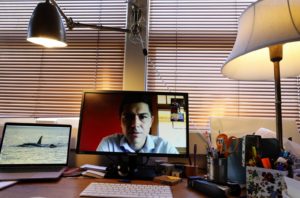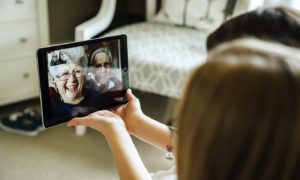A roundup of articles on Coronavirus and what people are doing to meet its challenges. To be added to as the day progresses….
By Emily Buder The Atlantic Selects, March 16, 2020, Video by Olmo Parenti
https://www.theatlantic.com/video/index/608113/italy-coronavirus/
When the Italian media began reporting on the increased community spread of the novel coronavirus across the country, Olmo Parenti, like many Italian citizens, didn’t take the threat of the pandemic too seriously. “My friends and I were almost mocking the few people who believed the issue was serious from the get-go,” Parenti, a young filmmaker, told me.
Just days later, Parenti felt like he was living in a different version of reality—a dystopian one. The number of positive cases had spiked dramatically. The entire country had shut down. The economy took a nosedive. Hospitals, overwhelmed with COVID-19 patients, were being forced to make impossible utilitarian decisions: Which critical patients would receive lifesaving artificial ventilation, while the others would effectively be left to die?
Parenti and his friends were disturbed by the fact that they had severely underestimated the situation, a perspective that perhaps contributed to the spread of the virus. “We read in the news that the U.S., England, Germany, and France were all taking the COVID-19 progression just as lightly as we had,” Parenti said. “We decided we had to redeem ourselves in some way.”
Together with other members of his filmmaking collective, Parenti put out a call for citizens across the country to film themselves in quarantine. “We asked them to talk in first person to the camera,” he said, “and give themselves advice based on their own past behavior.”
The resulting film, 10 Days, features messages from dozens of terrified Italians. The videos play as if warnings from the future. Like Parenti, many of the people who submitted quarantine videos chide themselves for not having taken precautionary measures, such as self-isolation and social distancing, as early as they could have.
“This isn’t all bullshit like you thought,” says one young man
Another woman, who is seen wearing a face mask, admits that she used to make fun of people wearing masks. “The worst-case scenario? That’s exactly what will happen,” she adds.
As though to underscore the importance of quarantine compliance across age groups, a teenager in the video reveals an eye-opening fact: “There are currently kids our age who are intubated and in intensive care.”
Many experts believe that the United States is just 10 days behind the level of severity of the pandemic in Italy. We are at a crucial inflection point, according to the surgeon general, Dr. Jerome Adams, and the time to prepare for what’s coming is now.
“This has been a humbling experience,” Parenti said. “But the cool thing about mistakes is that you can learn from other people’s—so learn from ours and don’t underestimate this.”
By Sunday, 24,747 cases had been diagnosed in Italy, up from 21,157 on Saturday—a record-breaking single-day increase. The country also reported 368 new fatalities, bringing the death toll to 1,809 nationwide.

Dr. Dakotah Lane, health director of the Lummi Nation, is in self-quarantine in Bellingham while awaiting test results for the novel coronavirus, or… (Alan Berner / The Seattle Times)
A Lummi Nation doctor is self-quarantined. But the tribe has been preparing for weeks for a coronavirus outbreak.
Lynda V. Mapes, Seattle Times, March 17, 2020
When Dakotah Lane decided to change careers and become a doctor, to come home and serve his people, he never thought he’d be in the middle of trying to protect his tribe from a pandemic.
Now Lummi Nation’s first physician from its own community is in self-quarantine, in an empty house. Lane determined he was exposed to the first person at the reservation to test positive for the coronavirus.
Lane is quarantined in his mother’s place while she is away on vacation, to protect his tribe — and his wife and three children, ages 8, 5 and 2, at home.
Lane, 39, and the tribe’s medical director, has no symptoms and is hoping for the best while waiting for test results.
No matter how it comes out, Lane said he is glad to be where he is. He came back to the reservation in 2016 to practice family medicine after getting his medical degree from Weill Cornell Medicine at Cornell University in New York. It was a switch for him after starting out as an electrical engineer with a degree from the University of Washington.
He felt called to serve his people.
Protection is what Lummi has been all about as the tribe has taken strong measures that began in February – and they’ve gone further than many governments to protect their people.
“At first in January we were just watching it, and didn’t expect anything,” Lane said. “There was a lot of doubt when we first started, there was a lot of disbelief, ‘Are we overblowing this, are we crying wolf?’ But in February, it became clear to us we need to start acting right now.
“Then when we had our first case, it became very real.”
Two more positive cases were reported by the tribe Tuesday evening; both people, including a tribal member, are in self-quarantine.
The tribe’s cultural lens helped launch a strong response, said Nickolaus Lewis, a member of the Lummi Indian Business Council and chairman of the nonprofit Northwest Portland Area Indian Health Board, serving 43 federally recognized tribes in Oregon, Washington and Idaho.
“A successful job is seeing lower numbers of deaths,” he said. “We don’t want to see our loved ones be buried. We struggle with that enough in normal day-to-day life. This is going to test us all.”
The tribe was prepared. Unlike public health resources in many communities outside the reservation, the tribal council had been building up the tribe’s health system, doubling the number of doctors in the past three years to eight. That includes Lane’s former high school soccer teammate, Justin Iwasaki, and Cristina Toledo-Cornell, a classmate from medical school. Tara Olsen, a Lummi tribal member, is the tribe’s health care administrator, “the oil that makes the machine run,” Lane said.
“This is so much a team effort, without them we would not be where we are today and that goes for our council,” Lane said. “We could just as easily have a boss that doesn’t listen, but they have been there right from the beginning.”
Lummi started gathering medical supplies, including test kits from a range of sources — including a vendor now sold out — and personal protective equipment in February, and reached out to the UW to arrange test processing. The tribe had 300 tests on hand as other clinics around the region were scrambling.
The Lummi Nation also has taken steps to bring medical care and support to their community, right to their homes. The tribe purchased iPads and Wi-Fi hot spots, dropped off at patients’ doorsteps for in-home, door-to-door telemedicine. The tribe also has drive-thru testing for anyone who meets the criteria for it. The tribe even set up a medical tent outside, for people who need hands-on examination.
All dental appointments have been canceled, and the dental staff, other than a skeleton crew for emergencies, has been repurposed to help with the virus response, including testing.
The tribe, before the state or federal authorities, called for extreme social distancing. But to make sure elders and others have what they need, food is being distributed door to door, and drive-ups to distribution points are available around the reservation for people still able to leave their homes.
“We have been taking this very seriously from the beginning,” said Lawrence Solomon, chairman of the Lummi Indian Business Council. “It is impacting our family; these are not just our citizens, these are our relatives, our brothers and our sisters, aunts, uncles and grandmothers and grandfathers.”
The tribe has emphasized empowering its health team as the core of its response, Lewis said.
“We are leading through the lens of protecting our people and that has enabled us to be very progressive, we are doing things other tribes and communities aren’t yet able to.” he said. “We knew we needed to get out of the way and let the professionals do their jobs and support our health team.’’
This is one community where vaccinations also have become a broadly accepted routine. “It’s just, ‘Talk to your grandparents, they can tell you the stories of why,’ ” Lane said.
The community is 100% mobilized now to stop this new threat, Lane said.
“All of these people are our relations. We want them to live.”

USA, Texas, Austin
Amid Coronavirus Outbreak, Social Distancing Doesn’t Have to Be Anti-Social
Fran Korten, Yes! Magazine, March 17, 2020
https://www.yesmagazine.org/opinion/2020/03/17/coronavirus-social-distancing/
Over the past two weeks, a new term has erupted in everyday speech. Social Distancing. That’s what we are all supposed to do. But that’s exactly what we should NOT do.
What we should do is practice physical distancing. Yes, we should not shake hands, gather in crowds, hug, or go to work when sick. But socially, now is the time to be close. And with our technology, we can do it.
For the past two Sundays, my church has held its services on YouTube. I was skeptical but found it works amazingly well. Not only do we hear a sermon and readings, we sing together, individuals offer their joys and concerns on the chat feature, and others send their sympathies or congratulations.
At the most recent service, we switched to Zoom for the “coffee hour” after the service for conversations. We are staying close as a community just when we need it most.
My kids live far away, but I’m practicing social closeness with them, too. I’m used to many phone calls with my younger daughter. Now we do them on Zoom—it’s like sitting in the same room. My older daughter likes to text—including with photographs and videos. We stay close.
Facebook, Twitter, Instagram, NextDoor, email, blogs. All these are ways to stay in contact and support one another. Even old-fashioned letters or cards strengthen the connection.
At this time of enormous stress, fear, and uncertainty, social isolation is dangerous to our well-being. Although we can’t experience closeness through jostling each other at a game, applauding together at a play, lingering over an intimate meal at a restaurant, we can use every tool available to stay socially close. We need each other now more than ever while staying physically distant.

